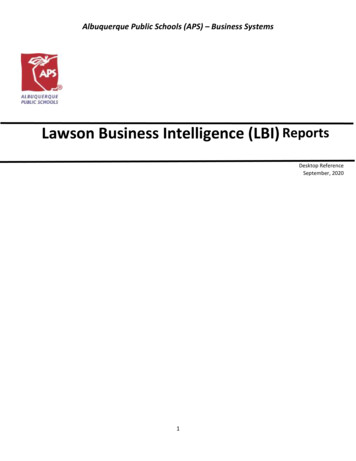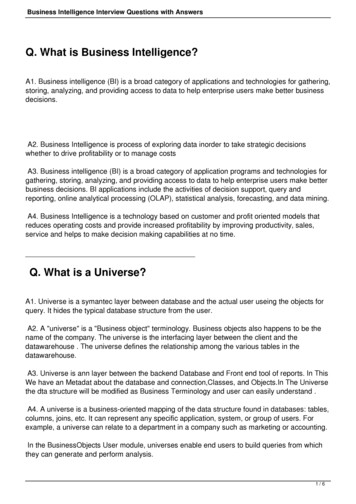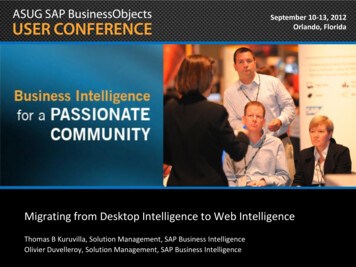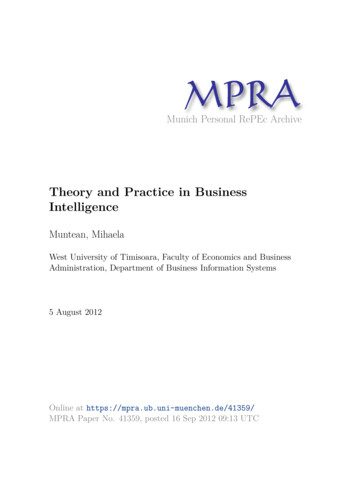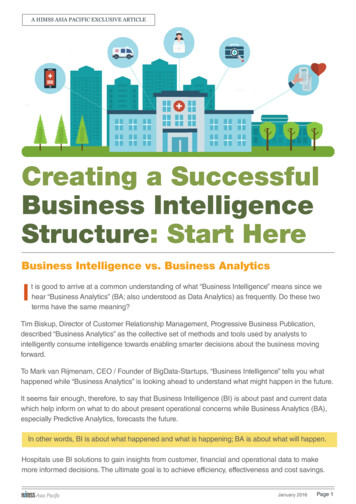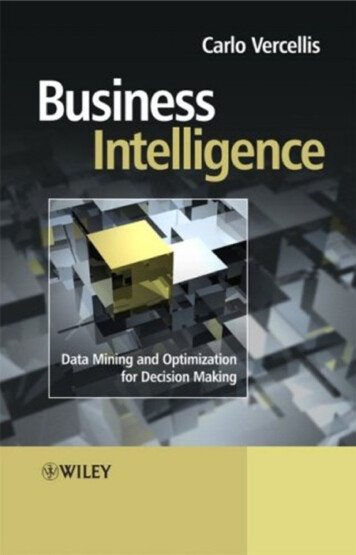
Transcription
Business IntelligenceBusiness Intelligence: Data Mining and Optimization for Decision Making Carlo Vercellis 2009 John Wiley & Sons, Ltd. ISBN: 978-0-470-51138-1
Business Intelligence:Data Mining and Optimizationfor Decision MakingCarlo VercellisPolitecnico di Milano, Italy.A John Wiley and Sons, Ltd., Publication
This edition first published 2009 2009 John Wiley & Sons LtdRegistered officeJohn Wiley & Sons Ltd, The Atrium, Southern Gate, Chichester, West Sussex, PO19 8SQ, United KingdomFor details of our global editorial offices, for customer services and for information about how to apply forpermission to reuse the copyright material in this book please see our website at www.wiley.com.The right of the author to be identified as the author of this work has been asserted in accordance with theCopyright, Designs and Patents Act 1988.All rights reserved. No part of this publication may be reproduced, stored in a retrieval system, or transmitted,in any form or by any means, electronic, mechanical, photocopying, recording or otherwise, except aspermitted by the UK Copyright, Designs and Patents Act 1988, without the prior permission of the publisher.Wiley also publishes its books in a variety of electronic formats. Some content that appears in print may notbe available in electronic books.Designations used by companies to distinguish their products are often claimed as trademarks. All brandnames and product names used in this book are trade names, service marks, trademarks or registeredtrademarks of their respective owners. The publisher is not associated with any product or vendor mentionedin this book. This publication is designed to provide accurate and authoritative information in regard to thesubject matter covered. It is sold on the understanding that the publisher is not engaged in renderingprofessional services. If professional advice or other expert assistance is required, the services of a competentprofessional should be sought.Library of Congress Cataloging-in-Publication DataVercellis, Carlo.Business intelligence : data mining and optimization for decision making / Carlo Vercellis.p. cm.Includes bibliographical references and index.ISBN 978-0-470-51138-1 (cloth) – ISBN 978-0-470-51139-8 (pbk. : alk. paper)1. Decision making–Mathematical models. 2. Business intelligence. 3. Data mining. I. Title.HD30.23.V476 2009658.4 038–dc222008043814A catalogue record for this book is available from the British Library.ISBN: 978-0-470-51138-1 (Hbk)ISBN: 978-0-470-51139-8 (Pbk)Typeset in 10.5/13pt Times by Laserwords Private Limited, Chennai, IndiaPrinted in the United Kingdom by TJ International, Padstow, Cornwall
ContentsPrefaceIxiiiComponents of the decision-making process11 Business intelligence1.1 Effective and timely decisions . . . . . . . . . . . . . . .1.2 Data, information and knowledge . . . . . . . . . . . . .1.3 The role of mathematical models . . . . . . . . . . . . .1.4 Business intelligence architectures . . . . . . . . . . . . .1.4.1 Cycle of a business intelligence analysis . . . . .1.4.2 Enabling factors in business intelligence projects .1.4.3 Development of a business intelligence system . .1.5 Ethics and business intelligence . . . . . . . . . . . . . .1.6 Notes and readings . . . . . . . . . . . . . . . . . . . . .336891113141718.21212324252933353640433 Data warehousing3.1 Definition of data warehouse . . . . . . . . . . . . . . . . . . .3.1.1 Data marts . . . . . . . . . . . . . . . . . . . . . . . .3.1.2 Data quality . . . . . . . . . . . . . . . . . . . . . . . .454549502 Decision support systems2.1 Definition of system . . . . . . . . . . . . . . . . .2.2 Representation of the decision-making process . . .2.2.1 Rationality and problem solving . . . . . . .2.2.2 The decision-making process . . . . . . . .2.2.3 Types of decisions . . . . . . . . . . . . . .2.2.4 Approaches to the decision-making process2.3 Evolution of information systems . . . . . . . . . .2.4 Definition of decision support system . . . . . . . .2.5 Development of a decision support system . . . . .2.6 Notes and readings . . . . . . . . . . . . . . . . . .
viCONTENTS3.23.33.4Data warehouse architecture . . . . . . . . . . . . . .3.2.1 ETL tools . . . . . . . . . . . . . . . . . . . .3.2.2 Metadata . . . . . . . . . . . . . . . . . . . .Cubes and multidimensional analysis . . . . . . . . .3.3.1 Hierarchies of concepts and OLAP operations3.3.2 Materialization of cubes of data . . . . . . . .Notes and readings . . . . . . . . . . . . . . . . . . .II Mathematical models and methods45675153545560616263Mathematical models for decision making4.1 Structure of mathematical models . . .4.2 Development of a model . . . . . . . .4.3 Classes of models . . . . . . . . . . . .4.4 Notes and readings . . . . . . . . . . .6565677075Data mining5.1 Definition of data mining . . . . . . . . . . . . . .5.1.1 Models and methods for data mining . . .5.1.2 Data mining, classical statistics and OLAP5.1.3 Applications of data mining . . . . . . . .5.2 Representation of input data . . . . . . . . . . . .5.3 Data mining process . . . . . . . . . . . . . . . .5.4 Analysis methodologies . . . . . . . . . . . . . .5.5 Notes and readings . . . . . . . . . . . . . . . . .777779808182849094Data preparation6.1 Data validation . . . . . . . . . . . .6.1.1 Incomplete data . . . . . . . .6.1.2 Data affected by noise . . . .6.2 Data transformation . . . . . . . . . .6.2.1 Standardization . . . . . . . .6.2.2 Feature extraction . . . . . .6.3 Data reduction . . . . . . . . . . . .6.3.1 Sampling . . . . . . . . . . .6.3.2 Feature selection . . . . . . .6.3.3 Principal component analysis6.3.4 Data discretization . . . . . .959596979999100100101102104109.Data exploration1137.1 Univariate analysis . . . . . . . . . . . . . . . . . . . . . . . . 113
CONTENTS7.27.37.47.1.1 Graphical analysis of categorical attributes . . . . . .7.1.2 Graphical analysis of numerical attributes . . . . . .7.1.3 Measures of central tendency for numerical attributes7.1.4 Measures of dispersion for numerical attributes . . .7.1.5 Measures of relative location for numerical attributes7.1.6 Identification of outliers for numerical attributes . . .7.1.7 Measures of heterogeneity for categorical attributes .7.1.8 Analysis of the empirical density . . . . . . . . . . .7.1.9 Summary statistics . . . . . . . . . . . . . . . . . . .Bivariate analysis . . . . . . . . . . . . . . . . . . . . . . . .7.2.1 Graphical analysis . . . . . . . . . . . . . . . . . . .7.2.2 Measures of correlation for numerical attributes . . .7.2.3 Contingency tables for categorical attributes . . . . .Multivariate analysis . . . . . . . . . . . . . . . . . . . . . .7.3.1 Graphical analysis . . . . . . . . . . . . . . . . . . .7.3.2 Measures of correlation for numerical attributes . . .Notes and readings . . . . . . . . . . . . . . . . . . . . . . .8 Regression8.1 Structure of regression models . . . . . . . . . . . . . .8.2 Simple linear regression . . . . . . . . . . . . . . . . .8.2.1 Calculating the regression line . . . . . . . . . .8.3 Multiple linear regression . . . . . . . . . . . . . . . .8.3.1 Calculating the regression coefficients . . . . .8.3.2 Assumptions on the residuals . . . . . . . . . .8.3.3 Treatment of categorical predictive attributes . .8.3.4 Ridge regression . . . . . . . . . . . . . . . . .8.3.5 Generalized linear regression . . . . . . . . . .8.4 Validation of regression models . . . . . . . . . . . . .8.4.1 Normality and independence of the residuals . .8.4.2 Significance of the coefficients . . . . . . . . .8.4.3 Analysis of variance . . . . . . . . . . . . . . .8.4.4 Coefficient of determination . . . . . . . . . . .8.4.5 Coefficient of linear correlation . . . . . . . . .8.4.6 Multicollinearity of the independent variables .8.4.7 Confidence and prediction limits . . . . . . . .8.5 Selection of predictive variables . . . . . . . . . . . . .8.5.1 Example of development of a regression model8.6 Notes and readings . . . . . . . . . . . . . . . . . . . 75176177178179180185
viii9CONTENTSTime series9.1 Definition of time series . . . . . . . . . . . . . . . . . .9.1.1 Index numbers . . . . . . . . . . . . . . . . . . .9.2 Evaluating time series models . . . . . . . . . . . . . . .9.2.1 Distortion measures . . . . . . . . . . . . . . . .9.2.2 Dispersion measures . . . . . . . . . . . . . . . .9.2.3 Tracking signal . . . . . . . . . . . . . . . . . . .9.3 Analysis of the components of time series . . . . . . . .9.3.1 Moving average . . . . . . . . . . . . . . . . . .9.3.2 Decomposition of a time series . . . . . . . . . .9.4 Exponential smoothing models . . . . . . . . . . . . . . .9.4.1 Simple exponential smoothing . . . . . . . . . . .9.4.2 Exponential smoothing with trend adjustment . .9.4.3 Exponential smoothing with trend and seasonality9.4.4 Simple adaptive exponential smoothing . . . . . .9.4.5 Exponential smoothing with damped trend . . . .9.4.6 Initial values for exponential smoothing models .9.4.7 Removal of trend and seasonality . . . . . . . . .9.5 Autoregressive models . . . . . . . . . . . . . . . . . . .9.5.1 Moving average models . . . . . . . . . . . . . .9.5.2 Autoregressive moving average models . . . . . .9.5.3 Autoregressive integrated moving average models9.5.4 Identification of autoregressive models . . . . . .9.6 Combination of predictive models . . . . . . . . . . . . .9.7 The forecasting process . . . . . . . . . . . . . . . . . . .9.7.1 Characteristics of the forecasting process . . . . .9.7.2 Selection of a forecasting method . . . . . . . . .9.8 Notes and readings . . . . . . . . . . . . . . . . . . . . .10 Classification10.1 Classification problems . . . . . . . . . . .10.1.1 Taxonomy of classification models10.2 Evaluation of classification models . . . .10.2.1 Holdout method . . . . . . . . . .10.2.2 Repeated random sampling . . . .10.2.3 Cross-validation . . . . . . . . . .10.2.4 Confusion matrices . . . . . . . . .10.2.5 ROC curve charts . . . . . . . . .10.2.6 Cumulative gain and lift charts . .10.3 Classification trees . . . . . . . . . . . . .10.3.1 Splitting rules . . . . . . . . . . . 8228229230233234236240
CONTENTS10.410.510.610.710.810.3.2 Univariate splitting criteria . . . . . . . . . . . . .10.3.3 Example of development of a classification tree .10.3.4 Stopping criteria and pruning rules . . . . . . . .Bayesian methods . . . . . . . . . . . . . . . . . . . . . .10.4.1 Naive Bayesian classifiers . . . . . . . . . . . . .10.4.2 Example of naive Bayes classifier . . . . . . . . .10.4.3 Bayesian networks . . . . . . . . . . . . . . . . .Logistic regression . . . . . . . . . . . . . . . . . . . . .Neural networks . . . . . . . . . . . . . . . . . . . . . .10.6.1 The Rosenblatt perceptron . . . . . . . . . . . . .10.6.2 Multi-level feed-forward networks . . . . . . . .Support vector machines . . . . . . . . . . . . . . . . . .10.7.1 Structural risk minimization . . . . . . . . . . . .10.7.2 Maximal margin hyperplane for linear separation10.7.3 Nonlinear separation . . . . . . . . . . . . . . . .Notes and readings . . . . . . . . . . . . . . . . . . . . .11 Association rules11.1 Motivation and structure of association rules11.2 Single-dimension association rules . . . . . .11.3 Apriori algorithm . . . . . . . . . . . . . . .11.3.1 Generation of frequent itemsets . . .11.3.2 Generation of strong rules . . . . . .11.4 General association rules . . . . . . . . . . .11.5 Notes and readings . . . . . . . . . . . . . .12 Clustering12.1 Clustering methods . . . . . . . . . . . . . .12.1.1 Taxonomy of clustering methods . .12.1.2 Affinity measures . . . . . . . . . . .12.2 Partition methods . . . . . . . . . . . . . . .12.2.1 K-means algorithm . . . . . . . . . .12.2.2 K-medoids algorithm . . . . . . . .12.3 Hierarchical methods . . . . . . . . . . . . .12.3.1 Agglomerative hierarchical methods12.3.2 Divisive hierarchical methods . . . .12.4 Evaluation of clustering models . . . . . . .12.5 Notes and readings . . . . . . . . . . . . . 07308310312315
xCONTENTSIII Business intelligence applications31713 Marketing models13.1 Relational marketing . . . . . . . . . . . . . . . . . . . .13.1.1 Motivations and objectives . . . . . . . . . . . . .13.1.2 An environment for relational marketing analysis13.1.3 Lifetime value . . . . . . . . . . . . . . . . . . .13.1.4 The effect of latency in predictive models . . . .13.1.5 Acquisition . . . . . . . . . . . . . . . . . . . . .13.1.6 Retention . . . . . . . . . . . . . . . . . . . . . .13.1.7 Cross-selling and up-selling . . . . . . . . . . . .13.1.8 Market basket analysis . . . . . . . . . . . . . . .13.1.9 Web mining . . . . . . . . . . . . . . . . . . . . .13.2 Salesforce management . . . . . . . . . . . . . . . . . . .13.2.1 Decision processes in salesforce management . .13.2.2 Models for salesforce management . . . . . . . .13.2.3 Response functions . . . . . . . . . . . . . . . . .13.2.4 Sales territory design . . . . . . . . . . . . . . . .13.2.5 Calls and product presentations planning . . . . .13.3 Business case studies . . . . . . . . . . . . . . . . . . . .13.3.1 Retention in telecommunications . . . . . . . . .13.3.2 Acquisition in the automotive industry . . . . . .13.3.3 Cross-selling in the retail industry . . . . . . . . .13.4 Notes and readings . . . . . . . . . . . . . . . . . . . . 4735235235435836014 Logistic and production models14.1 Supply chain optimization . . . . . . . . . . . . . .14.2 Optimization models for logistics planning . . . . .14.2.1 Tactical planning . . . . . . . . . . . . . . .14.2.2 Extra capacity . . . . . . . . . . . . . . . .14.2.3 Multiple resources . . . . . . . . . . . . . .14.2.4 Backlogging . . . . . . . . . . . . . . . . .14.2.5 Minimum lots and fixed costs . . . . . . . .14.2.6 Bill of materials . . . . . . . . . . . . . . .14.2.7 Multiple plants . . . . . . . . . . . . . . . .14.3 Revenue management systems . . . . . . . . . . . .14.3.1 Decision processes in revenue management14.4 Business case studies . . . . . . . . . . . . . . . . .14.4.1 Logistics planning in the food industry . . .14.4.2 Logistics planning in the packaging industry14.5 Notes and readings . . . . . . . . . . . . . . . . . .361362364364365366366369370371372373376376383384.
CONTENTS15 Data envelopment analysis15.1 Efficiency measures . . . . . . . . . . . .15.2 Efficient frontier . . . . . . . . . . . . .15.3 The CCR model . . . . . . . . . . . . .15.3.1 Definition of target objectives . .15.3.2 Peer groups . . . . . . . . . . . .15.4 Identification of good operating practices15.4.1 Cross-efficiency analysis . . . . .15.4.2 Virtual inputs and virtual outputs15.4.3 Weight restrictions . . . . . . . .15.5 Other models . . . . . . . . . . . . . . .15.6 Notes and readings . . . . . . . . . . . .xi.385386386390392393394394395396396397Appendix A Software tools399Appendix B Dataset repositories401References403Index413
PrefaceSince the 1990s, the socio-economic context within which economic activitiesare carried out has generally been referred to as the information and knowledgesociety. The profound changes that have occurred in methods of production andin economic relations have led to a growth in the importance of the exchangeof intangible goods, consisting for the most part of transfers of information.The acceleration in the pace of current transformation processes is due to twofactors. The first is globalization, understood as the ever-increasing interdependence between the economies of the various countries, which has led to thegrowth of a single global economy characterized by a high level of integration.The second is the new information technologies, marked by the massive spreadof the Internet and of wireless devices, which have enabled high-speed transfers of large amounts of data and the widespread use of sophisticated meansof communication.In this rapidly evolving scenario, the wealth of development opportunitiesis unprecedented. The easy access to information and knowledge offers severaladvantages to various actors in the socio-economic environment: individuals,who can obtain news more rapidly, access services more easily and carry outon-line commercial and banking transactions; enterprises, which can developinnovative products and services that can better meet the needs of the users,achieving competitive advantages from a more effective use of the knowledgegained; and, finally, the public administration, which can improve the servicesprovided to citizens through the use of e-government applications, such ason-line payments of tax contributions, and e-health tools, by taking into accounteach patient’s medical history, thus improving the quality of healthcare services.In this framework of radical transformation, methods of governance withincomplex organizations also reflect the changes occurring in the socio-economicenvironment, and appear increasingly more influenced by the immediate accessto information for the development of effective action plans. The term complex organizations will be used throughout the book to collectively refer toa diversified set of entities operating in the socio-economic context, including enterprises, government agencies, banking and financial institutions, andnon-profit organizations.
xivPREFACEThe adoption of low-cost massive data storage technologies and the wideavailability of Internet connections have made available large amounts of datathat have been collected and accumulated by the various organizations over theyears. The enterprises that are capable of transforming data into information andknowledge can use them to make quicker and more effective decisions and thusto achieve a competitive advantage. By the same token, on the public administration side, the analysis of the available information enables the developmentof better and innovative services for citizens. These are ambitious objectivesthat technology, however sophisticated, cannot perform on its own, without thesupport of competent minds and advanced analysis methodologies.Is it possible to extract, from the huge amounts of data available, knowledgewhich can then be used by decision makers to aid and improve the governanceof the enterprises and the public administration?Business intelligence may be defined as a set of mathematical models andanalysis methodologies that systematically exploit the available data to retrieveinformation and knowledge useful in supporting complex decision-making processes.Despite the somewhat restrictive meaning of the term business, which seemsto confine the subject within the boundaries of enterprises, business intelligencesystems are aimed at companies as well as other types of complex organizations,as mentioned above.Business intelligence methodologies are interdisciplinary and broad, spanning several domains of application. Indeed, they are concerned with therepresentation and organization of the decision-making process, and thus withthe field of decision theory; with collecting and storing the data intended tofacilitate the decision-making process, and thus with data warehousing technologies; with mathematical models for optimization and data mining, andthus with operations research and statistics; finally, with several applicationdomains, such as marketing, logistics, accounting and control, finance, servicesand the public administration.We can say that business intelligence systems tend to promote a scientificand rational approach to managing enterprises and complex organizations. Eventhe use of an electronic spreadsheet for assessing the effects induced on thebudget by fluctuations in the discount rate, despite its simplicity, requires onthe part of decision makers a mental representation of the financial flows.A business intelligence environment offers decision makers information andknowledge derived from data processing, through the application of mathematical models and algorithms. In some instances, these may merely consist of thecalculation of totals and percentages, while more fully developed analyses makeuse of advanced models for optimization, inductive learning and prediction.
PREFACExvIn general, a model represents a selective abstraction of a real system,designed to analyze and understand from an abstract point of view the operatingbehavior of the real system. The model includes only the elements of the systemdeemed relevant for the purpose of the investigation carried out. It is worthquoting the words of Einstein on the subject of model development: ‘Everythingshould be made as simple as possible, but not simpler.’Classical scientific disciplines, such as physics, have always made use ofmathematical models for the abstract representation of real systems, while otherdisciplines, such as operations research, have dealt with the application ofscientific methods and mathematical models to the study of artificial systems,such as enterprises and complex organizations.‘The great book of nature’, as Galileo wrote, ‘may only be read by thosewho know the language in which it was written. And this language is mathematics.’ Can we apply also to the analysis of artificial systems this profoundinsight from one of the men who opened up the way to modern science?We believe so. Nowadays, the mere intuitive abilities of decision makersmanaging enterprises or the public administration are outdone by the complexity of governance of current organizations. As an example, consider the designof a marketing campaign in dynamic and unpredictable markets, where howevera wealth of information is available on the buying behavior of the consumers.Today, it is inconceivable to leave aside the application of advanced inferential learning models for selecting the recipients of the campaign, in orderto optimize the allocation of resources and the redemption of the marketingaction.The interpretation of the term business intelligence that we have illustratedand that we intend to develop in this book is much broader and deeper comparedto the narrow meaning publicized over the last few years by many softwarevendors and information technology magazines. According to this latter vision,business intelligence methodologies are reduced to electronic tools for querying, visualization and reporting, mainly for accounting and control purposes.Of course, no one can deny that rapid access to information is an invaluabletool for decision makers. However, these tools are oriented toward businessintelligence analyses of a passive nature, where the decision maker has alreadyformulated in her mind some criteria for data extraction. If we wish businessintelligence methodologies to be able to express their huge strategic potential,we should turn to active forms of support for decision making, based on thesystematic adoption of mathematical models able to transform data not onlyinto information but also into knowledge, and then knowledge into actual competitive advantage. The distinction between passive and active forms of analysiswill be further investigated in Chapter 1.
xviPREFACEOne might object that only simple tools based on immediate and intuitiveconcepts have the ability to prove useful in practice. In reply to this objection,we cannot do better than quote Vladimir Vapnik, who more than anyone hascontributed to the development of inductive learning models: ‘Nothing is morepractical than a good theory.’Throughout this book we have tried to make frequent reference to problemsand examples drawn from real applications in order to help readers understandthe topics discussed, while ensuring an adequate level of methodological rigorin the description of mathematical models.Part I describes the basic components that make up a business intelligence environment, discussing the structure of the decision-making process andreviewing the underlying information infrastructures. In particular, Chapter 1outlines a general framework for business intelligence, highlighting the connections with other disciplines. Chapter 2 describes the structure of the decisionmaking process and introduces the concept of a decision support system, illustrating the main advantages it involves, the critical success factors and someimplementation issues. Chapter 3 presents data warehouses and data marts, firstanalyzing the reasons that led to their introduction, and then describing on-lineanalytical processing analyses based on multidimensional cubes.Part II is more methodological in character, and offers a comprehensiveoverview of mathematical models for pattern recognition and data mining.Chapter 4 describes the main characteristics of mathematical models used forbusiness intelligence analyses, offering a brief taxonomy of the major classesof models. Chapter 5 introduces data mining, discussing the phases of a datamining process and their objectives. Chapter 6 describes the activities of datapreparation for business intelligence and data mining; these include data validation, anomaly detection, data transformation and reduction. Chapter 7 provides adetailed discussion of exploratory data analysis, performed by graphical methods and summary statistics, in order to understand the characteristics of theattributes in a dataset and to determine the intensity of the relationships amongthem. Chapter 8 describes simple and multiple regression models, discussingthe main diagnostics for assessing their significance and accuracy. Chapter 9illustrates the models for time series analysis, examining decomposition methods, exponential smoothing and autoregressive models. Chapter 10 is entirelydevoted to classification models, which play a prominent role in pattern recognition and learning theory. After a description of the evaluation criteria, themain classification methods are illustrated; these include classification trees,Bayesian methods, neural networks, logistic regression and support vectormachines. Chapter 11 describes association rules and the Apriori algorithm.Chapter 12 presents the best-known clustering models: partition methods, such
PREFACExviias K-means and K-medoids, and hierarchical methods, both agglomerative anddivisive.Part III illustrates the applications of data mining to relational marketing(Chapter 13), models for salesforce planning (Chapter 13), models for supply chain optimization (Chapter 14) and analytical methods for performanceassessment (Chapter 15).Appendix A provides information and links to software tools used to carryout the data mining and business intelligence analyses described in the book.Preference has been given to open source software, since in this way readerscan freely download it from the Internet to practice on the examples given.By the same token, the datasets used to exemplify the different topics are alsomostly taken from repositories in the public domain. Appendix B includes ashort description of the datasets used in the various chapters and the links tosites that contain these as well as other datasets useful for experimenting withand comparing the analysis methodologies.Bibliographical notes at the end of each chapter, highly selective as theyare, highlight other texts that we found useful and relevant, as well as researchcontributions of acknowledged historical value.This book is aimed at three main groups of readers. The first are studentsstudying toward a master’s degree in economics, business management or otherscientific disciplines, and attending a university course on business intelligencemethodologies, decision support systems and mathematical models for decision making. The second are students on doctoral programs in disciplines ofan economic and management nature. Finally, the book may also prove usefulto professionals wishing to update their knowledge and make use of a methodological and practical reference textbook. Readers belonging to this last groupmay be interested in an overview of the opportunities offered by business intelligence systems, or in specific methodological and applied subjects dealt within the book, such as data mining techniques applied to relational marketing,salesforce planning models, supply chain optimization models and analyticalmethods for performance evaluation.At Politecnico di Milano, the author leads the research group MOLD –Mathematical modeling, optimization, learning from data, which conductsmethodological research activities on models for inductive learning, prediction, classification, optimization,
Business Intelligence: Data Mining and Optimization for Decision Making Carlo Vercellis Politecnico d
